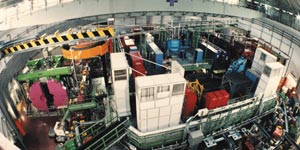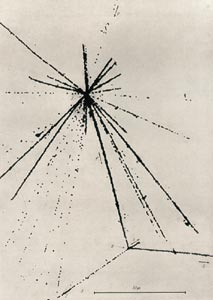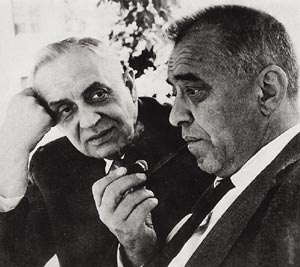A new experiment at the Frascati laboratory’s φ-factory is set to investigate the strange world of the hypernucleus.

In 1953 Marian Danysz and Jerzy Pniewski, two Polish physicists studying cosmic radiation, observed the first hypernucleus. The interaction of a high-energy proton with a nucleus in the emulsions they were using as a detector produced a hyperfragment – a nucleus containing a Λ particle. This pioneering observation initiated a new field of fundamental research – hypernuclear physics. The hypernucleus itself provides a unique laboratory suitable not only for studying nuclear structure in the presence of a strange quark, but also for probing weak interactions between baryons.
During the past 50 years, hypernuclei have been copiously produced at CERN (during the 1960s and 1970s), BNL (1970s-80s) and KEK (1980s-90s), first using extracted beams of negative kaons, and subsequently employing much more intense beams of positive pions. Now, in the year of the 50th anniversary of hypernuclear physics, the INFN’s Frascati National Laboratory in Italy is about to start an intense and innovative programme of hypernuclear studies.
The DAFNE φ-factory
The Frascati laboratory is home to DAFNE (Double Annular ring for Nice Experiments), an electron-positron collider dedicated to the production of large numbers of the φ resonance. DAFNE con-sists of two almost circular rings, one for the electrons and the other for the positrons, which overlap in two straight sections where the beams collide head-on. The energy of each beam is set to 510 MeV/c2 in order to produce the φ(1020) particle.
DAFNE is currently the only running φ-factory in the world, and was designed with the main aim of exploring rare physical phenomena with very high accuracy. The interest in the φ resonance arises from the fact that it decays mainly to a kaon-antikaon pair – particles that showed such unexpected features, right from their discovery in 1947, that a new physical entity called “strangeness” was introduced to explain their characteristics. Now DAFNE is producing φ particles at the rate of 12 million per day, and further improvements are predicted. The φ-factory is a clean and abundant source of low-energy neutral and charged kaons (~16 MeV/c2 kinetic energy) suitable for exploring the open problems related to the strange flavour degree of freedom.
The study of neutral kaons led to the discovery in 1964 of a unique phenomenon: the violation of CP symmetry by the weak interaction. Detailed measurement of the fundamental parameters of this violation is still one of the most challenging open problems of modern physics. The KLOE (K Long Experiment) apparatus, located in the first DAFNE interaction region, is devoted mainly to these studies.
Charged kaons, on the other hand, can be used to insert strangeness inside a nucleus, as a probe to investigate the strong force that “glues” matter together. The DEAR (DAFNE Exotic Atoms Research) experiment is using negative kaons from DAFNE to produce kaonic atoms and study their properties. The goal is the precise measurement of the strong interaction shifts and the widths of the Kα line of kaonic hydrogen. After a test period with nitrogen, the DEAR collaboration has completed data-taking with hydrogen.

However, the main user of charged kaons – more precisely negative kaons – will be the FINUDA experiment (FIsica NUcleare a DAfne). When a K– interacts with a neutron in a nucleus, it can transform it into a Λ hyperon, turning the nucleus into a hypernucleus. The FINUDA experiment, located in the second interaction region of the Frascati machine, is starting data-taking this year to explore the physics of hypernuclei in a completely new way.
Before explaining more about FINUDA, it should be mentioned that the high currents (more than 1 A) circulating inside the DAFNE machine produce high fluxes of synchrotron radiation in the UV and soft X-ray wavelength region. This radiation is used to perform high-quality studies of solid-state and biological physics. Photons in the soft X-ray energy range (1-7 keV) are extracted from the DAFNE wiggler with a horizontal collection angle of 15 mrad; the beam is then split into two separate lines. A third beamline, SINBAD (Synchrotron Infrared Beamline at DAFNE), operates in the infrared range. Here the photons are extracted from one of the DAFNE bending magnets with a vertical acceptance angle of about 40 mrad.
The FINUDA experiment
The highly innovative FINUDA experiment is the first hypernuclear physics experiment to take place at a collider, and has prompted a new era in this field of research. The specific aim of FINUDA is to produce hypernuclei by stopping the negative kaons originating from φ decay in a nuclear target. The reaction involved is: K– + AZ → AΛZ + π–. By precisely measuring the momentum of the outgoing π–, it is possible to determine the energy level of the hypernucleus AΛZ produced. This approach has some advantages when compared with other experimental techniques using extracted K– beams on a fixed target. The low kinetic energy of the DAFNE kaons allows them to be stopped in a very thin target (~0.1 g/cm2 compared with some g/cm2 for fixed-target experiments). Therefore, the energy straggling of the π– that tags the hypernucleus formation is strongly reduced, and so high-resolution spectroscopic studies are possible. Moreover, kaons at DAFNE are emitted isotropically, and the detector acceptance can therefore be quite large. This feature, combined with a good machine luminosity, provides high hypernuclear counting rates: with L = 1032 cm-2s-1, more than 100 hypernuclear events per hour are expected.
FINUDA will investigate a wide programme of high-statistics studies on different hypernuclei. This is possible because the target station of the apparatus is segmented, and up to eight different solid-state targets can be mounted into the detector at the same time. The FINUDA apparatus itself is a complex magnetic spectrometer designed to detect both the π– emitted in hypernucleus formation, and the products of hypernuclei decay. This is a unique feature in the panorama of studies in hypernuclear physics, which will enable simultaneous exploration of hypernuclear spectroscopy and hypernuclei decay modes.
The Λ particle is the lightest hyperon, so it is stable from the point of view of the strong interaction, and allows the formation of stable nuclear systems. Its lifetime in free space is typically 260 ps, before it decays through a weak interaction, emitting a nucleon and a pion. Nevertheless, since the momentum of the outgoing nucleon is below the Fermi momentum, when the Λ particle is embedded in nuclear matter, the Pauli principle inhibits this decay process. Therefore, when a Λ hyperon is attached to a nucleus, it experiences new decays – the so-called “non-mesonic decays” – for which few data are available. These processes are essentially weak interactions between the Λ particle and a nucleon, resulting in a pair of nucleons of high momentum (Λ + N → N + N). These reactions are extremely interesting because they allow us to explore the four-fermion, strangeness-changing, baryon-baryon weak interaction. This is a good way to study the ΛN interaction, as it is very difficult to produce hyperon beams.

Another important aspect of non-mesonic Λ decays is related to the ΔI = 1/2 empirical rule. The weak decay of hyperons may occur, in principle, with isospin change ΔI = 1/2 or 3/2. However, the values of the experimental decay branching ratios imply a dominance of a factor 20 of ΔI = 1/2 over ΔI = 3/2. Nevertheless, experimental analysis of some non-mesonic decay channels seems to suggest a strong violation of this rule. The latest measurements of the ratio between neutron- and proton-induced decay modes performed at KEK on 28ΛSi and 12ΛC give results close to 1 or greater, while theoretical calculations, imposing the ΔI = 1/2 rule, predict values well below unity. Precise measurements of the relative branching ratios of the non-mesonic decays could therefore provide new information about the relative importance of the ΔI = 1/2 and ΔI = 3/2 amplitudes of the weak Hamiltonian.
Charged particles emitted following hypernucleus production and/or decay are detected in the FINUDA cylindrical magnetic volume (1.1 T, 1 m radius, 2 m length) by four different detectors, each one optimized for a different task. Silicon microstrips detect the hypernuclear vertex, drift chambers and straw tubes reconstruct charged-particle trajectories, and plastic scintillators produce the trigger signal and detect neutrons.

Each element of the FINUDA apparatus is a small gem of mechanics and electronics. As low-energy particles are involved, only light materials have been used for the construction to minimize disturbance of the particle properties. For the same reasons, the whole detector is embedded in a helium atmosphere. In fact, if air is left inside the apparatus, the momentum resolution Δp/p would be worsened from 0.3% to 1.5%. A momentum resolution of 0.3% will provide an energy resolution for hypernuclear levels of about 750 keV/c2, the best ever achieved with a magnetic spectrometer.
The design, assembly and installation of the FINUDA detector, which began in 1997, has involved around 50 physicists, mainly Italians, together with a dozen engineers and technicians. This January the detector rolled into the DAFNE beamline, and data collection will begin soon. This year’s data-taking will be performed with the following target set: two 6Li, one 7Li, three 12C, one 27Al and one 58V. Three targets of carbon are necessary to produce 12ΛC, the most studied hypernucleus, in order to calibrate the spectrometer and measure, with high statistics, the non-mesonic decay channels. With 250 pb-1, the non-mesonic decays (Λ + p → p + n; Λ + n → n + n) will be measured with a statistical accuracy better than 10%, a world record for this kind of measurement. On the other hand, with 6Li targets, some light hypernuclear systems (6ΛHe, 5ΛHe, 4ΛHe, 4ΛH) will be produced and studied, while heavier targets have been chosen to start a complete survey of hypernuclei with different atomic numbers.
Despite its age, hypernuclear physics is seeing a renaissance. Large new projects are planned or are starting at the Jefferson Laboratory in the US, the Japanese Hadron Facility at Tokai, and the new European Hadron Facility under study at GSI. In all of these laboratories, which exploit different production techniques, hypernuclei will be used to shed new light on the non-perturbative QCD sector and on fundamental symmetries in the low-energy domain. To fulfil this programme, detailed spectroscopic studies will be performed on hypernuclei with single or even multiple strangeness content, together with high-resolution researches on spin observables of the ΛN potential. FINUDA, with its present programme, and with future upgrades oriented towards γ-ray hypernuclear spectroscopy, is the first step into this new era.





